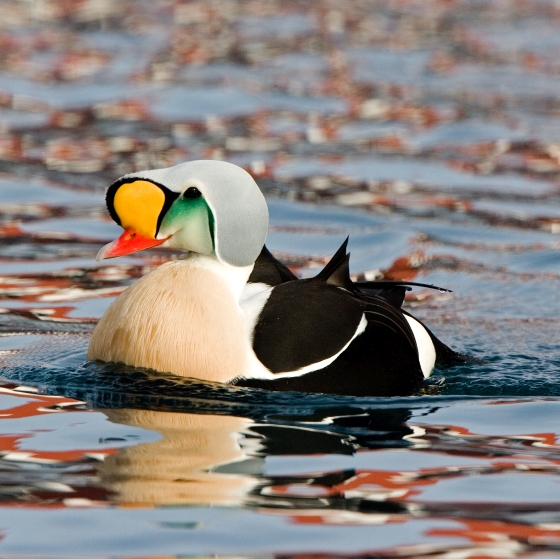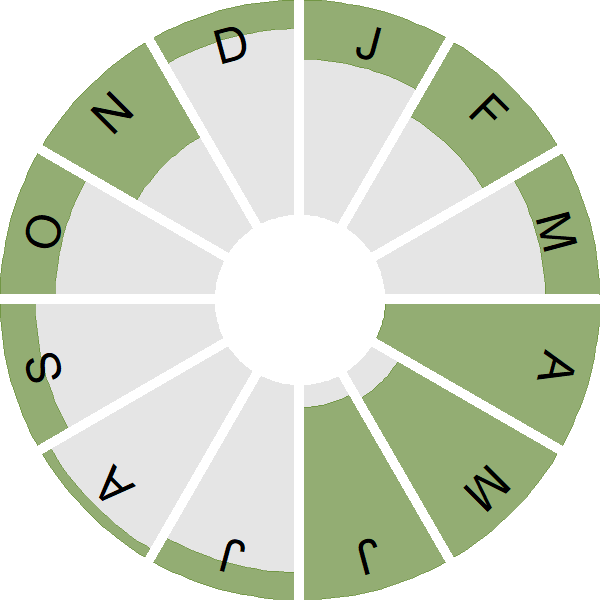King Eider

Introduction
This handsome seaduck is a scarce visitor from its northern breeding grounds. Although it may be recorded at any time of year, most records are from northern Britain in the winter months.
The female King Eider does not feed very often during the three week incubation period. One female was not observed to leave her nest for seven days, until being flushed by an Arctic Fox.

Key Stats
Status and Trends
Conservation Status
Population Size
Population Change
Population trends of this scarce species are not routinely monitored.
Distribution
King Eiders are scarce vagrants but several individuals winter most years, usually associated with Eider flocks and often in northern Britain.
Occupied 10-km squares in UK
2007/08–10/11
or view it on Bird Atlas Mapstore.
2008–11
or view it on Bird Atlas Mapstore.
European Distribution Map
Distribution Change
This vagrant has been recorded in several atlases so we have been able to map distribution changes. However, as a rarity these may not show a consistent pattern of change.
Change in occupied 10-km squares in the UK
from 1981–84 to 2007–11
or view it on Bird Atlas Mapstore.
Seasonality
King Eider is a scarce vagrant, with many records relating to long-staying individuals that may be seen in almost any month of the year.
Weekly pattern of occurrence
The graph shows when the species is present in the UK, with taller bars indicating a higher likelihood of encountering the species in appropriate regions and habitats.

Movement
Britain & Ireland movement
Biology
Survival and Longevity
Survival is shown as the proportion of birds surviving from one year to the next and is derived from bird ringing data. It can also be used to estimate how long birds typically live.
Classification, names and codes
Classification and Codes
- Order: Anseriformes
- Family: Anatidae
- Scientific name: Somateria spectabilis
- Authority: Linnaeus, 1758
- BTO 2-letter code: KE
- BTO 5-letter code: KINEI
- Euring code number: 2070
Alternate species names
- Catalan: èider reial
- Czech: kajka královská
- Danish: Kongeederfugl
- Dutch: Koningseider
- Estonian: kuninghahk
- Finnish: kyhmyhaahka
- French: Eider à tête grise
- German: Prachteiderente
- Hungarian: cifra pehelyréce
- Icelandic: Æðarkóngur
- Irish: Éadar Taibhseach
- Italian: Re degli edredoni
- Latvian: krašna pukpile
- Lithuanian: skiauteretoji gaga
- Norwegian: Praktærfugl
- Polish: (edredon) turkan
- Portuguese: êider-real
- Slovak: kajka hrbozobá
- Slovenian: pisana gaga
- Spanish: Éider real
- Swedish: praktejder
- Welsh: Hwyaden Fwythblu'r Gogledd
More Evidence
More evidence from Conservation Evidence.com
Partners
Citing BirdFacts
If you wish to cite particular content in this page (e.g. a specific value) it is best to use the original sources as linked in the page. For a more general citation of the whole page please use: BTO (20XX) BirdFacts Species: profiles of birds occurring in the United Kingdom. BTO, Thetford (www.bto.org/birdfacts, accessed on xx/xx/xxxx).

